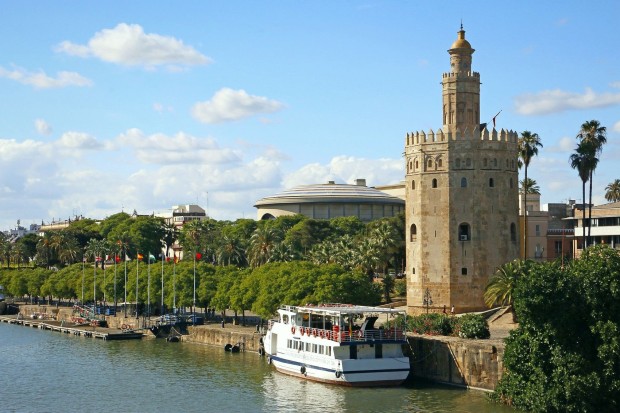The Islamic civilization left in Spain a huge artistic and architectonic heritage. For eight centuries, a significant part of Spain was under Muslim rule. That period not only introduced in Spain important scientific, agricultural, cultural advances (as it also did in Europe), but also left impressive examples of architecture, which nowadays still decorate the Spanish cities. This heritage reminds us the shared history and the cultural proximity that we have with that Islamic civilization. The Spanish newspaper, La Opinión de Tenerife, shows us some of these magnificent architectonic jewels.
The Muslim rule left in Spain a huge architectonic and monumental heritage, which in plenty of occasions preserves the splendor of a civilization that reached an extraordinary level of development and artistic sophistication. Palaces, mosques and fortresses continue to be proud witnesses of an essential era of our history, and are still today some of the European most visited monuments.
The Alhambra
Granada’s Alhambra complex is without doubts the architectonic and artistic Muslim landmark in Spain. It is the best Arab palace in the world and one of the world’s most spectacular monuments that exudes beauty in each of its halls and yards. The residence of the Nasrid Kingdom created a space for the pleasure of the senses, in which harmony and the refinement of the design and the decoration of Muslim civilization reached almost unparalleled levels of perfection.
The Generalife
Placed next to the Alhambra, the Generalife is the villa that the Muslim kings used as a place for rest and leisure. As in the Alhambra, the systems of water canalization that were used, stand out. However, the sublime beauty of the enclosure lies in the harmony and fineness of the space distribution and the design and care of gardens, yards and water tanks.
Mosque-Cathedral of Córdoba
If the Alhambra and the Generalife are two examples of civil architecture in Spain, Córdoba’s Mosque-Cathedral is its equivalent in the religious field. Initially it was a Visigothic basilica, but the Arabs built over it a worship area, whose startling column forest, is its most characteristic sign of identity. But the temple (which today also houses the Cathedral of Our Lady of the Assumption) also exudes beauty in its doors and mainly in its scrumptious mihrab.
Medina Azahara
Unfortunately, the Arab complex of Medina Azahara in Córdoba, has not been able to be preserved to the present day in all its splendor. Conceived as a palace and city of Cordoba’s Caliph Abderrahman III, we can still admire its ancient strength in the remains of the Palace of Zahra and its two big halls. Its marble pavements and its geometrical and flowery decoration still stand out.
The Aljafería Palace
Aljafería’s Palace is the proof that the legacy of the Muslim civilization is not reduced only to the south of the Iberian Peninsula. This fortress, which has suffered various modifications through its history and that today’s appears like a Cristian castle, houses in its interior, the design and the ornamentation of the ancient Muslim alcazar fortress. It was the symbol of the power of the Taifa Kingdoms, represented in the the lobed arches, the mosque and the courtyard. Today it houses the Parliament of Aragon.
The Giralda
The Giralda, which is Seville’s symbol, stands nowadays as the imposing bell tower of the cathedral. Nevertheless, in its origins it was the mosque’s minaret. The two inferior thirds of the current tower are exactly thoseof the Muslim edification. They are recognizable due to their Arab ornamentation. A spiral ramp allows to reach to the top.
Torre del Oro
This tower, of Arabs origins, has been rebuild in several occasions. In its origins it had a defensive role because it was part of the walls with which the Alcazar protected the city. After Seville was reconquered, it housed a chapel and became even a prison. It is called Torre del Oro due to the reflection of his color over the Guadalquivir river, next to which it is built.
Alcazaba of Málaga
This stronghold and palace which was designed like an enclosure of concentric walls, is another of the great examples of the Arabic architecture in Spain. Attached to the feet of the Mount Gibralfaro, the Alcazaba doesn’t preserve even half of its extension, but the importance of the place can be deduced from the currently visible elements. The areas of its urban design can still been seen, with doors, arches and the ancient neighborhood of houses.
Mosque of Cristo de la Luz
The hermitage of Cristo de la Luz, which was previously Bab al-Mardum Mosque or the Mosque of Cristo de la Luz, is the best Muslim temple preserved in Toledo and an example of Córdoba’s Caliphate splendor. Later on, when the small area converted into Christianity, a new carcass of Mudejar art, which gives shape to the hermitage’s apse, would be added.
Gormaz Castle
Another example of the Muslim architecture in the north of the peninsula is the Gormaz fortress, located in Soria, close to Burgo de Osma. Its imposing wall raises at a promontory in the Castilian field. A part of its importance as military site, this construction was Europe’s biggest medieval fortress. Its caliphal door carries the stamp of Muslim art.
Source: La Opinión de Tenerife

























No Comments